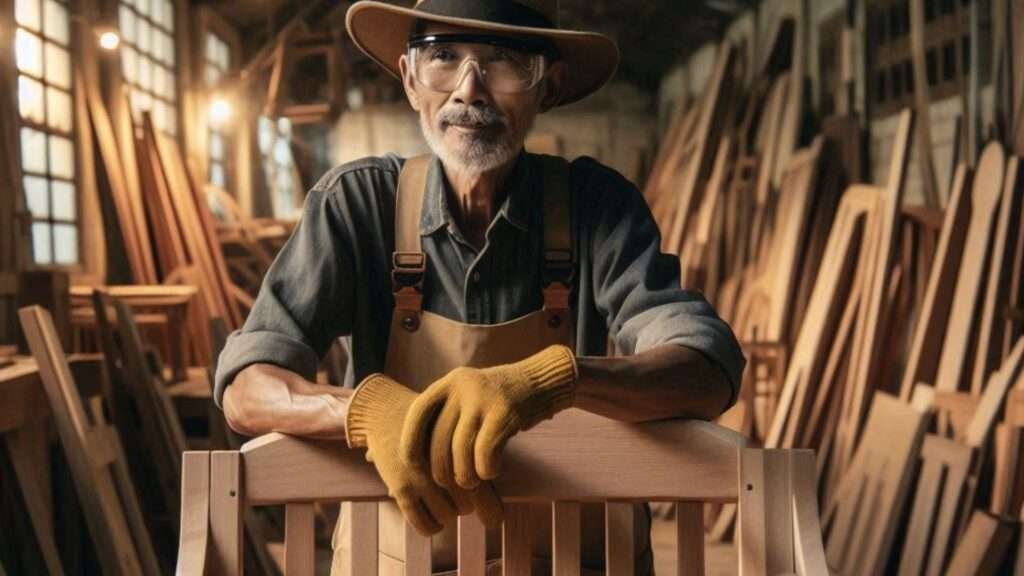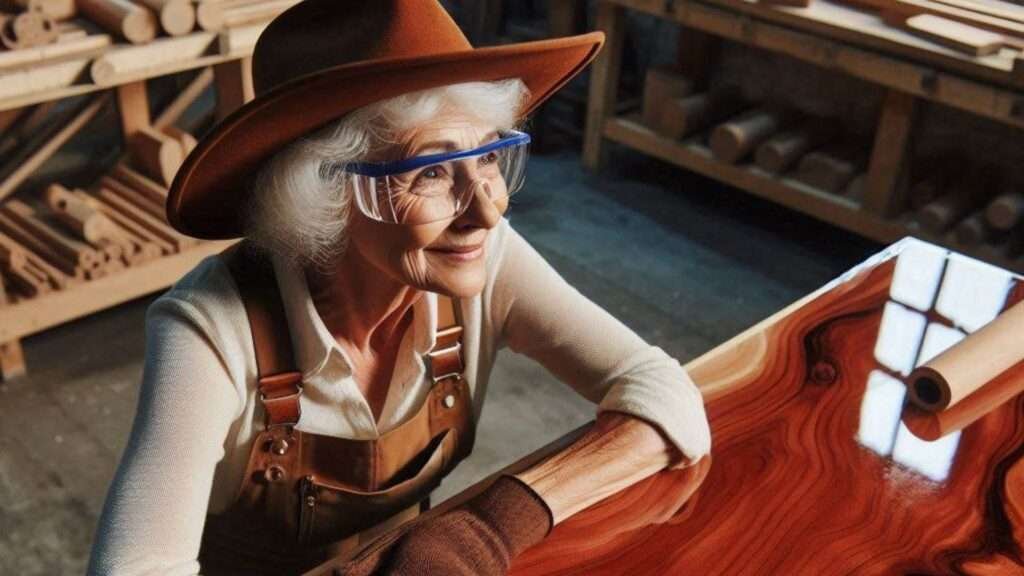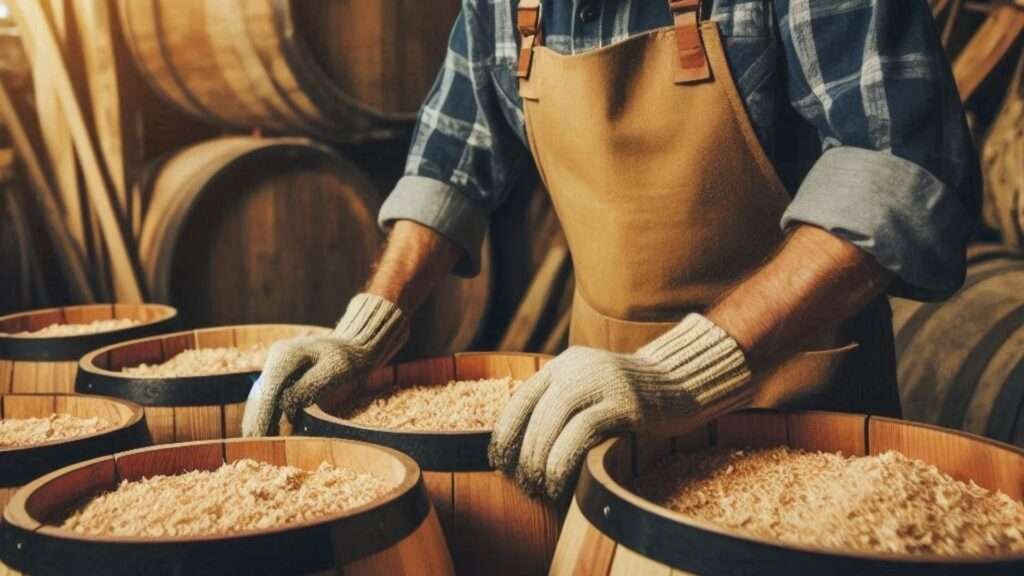Ensure Wood Quality & Product Longevity With Wood Seasoning.
With this article I’m exploring the critical
process of wood seasoning in the timber and timber-centric industry’s.
Wood seasoning, the controlled drying of freshly
cut timber, is essential for enhancing wood quality, durability, and
performance in various applications.
I cover the importance of proper moisture content,
different seasoning techniques, quality control measures and the broader
implications for sustainability and the wood industry.
The 6 Key Points Of This Article Are:
1.
The significance of reducing wood
moisture content to prevent issues such as warping, cracking, and biological
degradation.
2.
Comparison of air drying and kiln
drying methods, discussing their advantages and limitations.
3.
The impact of proper seasoning on
dimensional stability and structural integrity of wood products.
4.
Quality control measures in the
seasoning process, including moisture monitoring and defect inspections.
5.
The role of wood preservation
techniques in extending timber lifespan and expanding its applications.
6.
The importance of sustainable
forestry practices and their economic and environmental impacts.
You’ll find with this article that I very much emphasize
that mastering wood seasoning techniques is crucial for producing high-quality
timber products, improving efficiency, and contributing to sustainability in
the wood industry.
Table
Of Contents.
1.0 Understanding
Wood Seasoning.
·
Moisture-Related
Issues & The Consequences of Improper Seasoning
2.0 Air
Drying and Kiln Drying.
·
Air
Drying Process, Kiln Drying Process & A Comparison Of Methods.
3.0 Consequences
of Improper Wood Seasoning.
·
Warping
and Distortion, Cracking and Splitting & Structural Weakness.
4.0 Moisture Content And Wood Behaviour.
·
Hygroscopic
Nature of Wood & Effects on Different Wood Species.
5.0 Preventing
Defects Via Proper Wood Seasoning.
·
Common
Defects & Proper Seasoning Techniques.
6.0 Dimensional
Stability: Why It Matters So Much.
·
Impact
on Wood Performance And Long-term Benefits.
7.0 Drying
Techniques in Wood Seasoning.
·
Detailed
Air Drying Process, Kiln Drying Methods And Equipment.
8.0 Wood
Preservation and Seasoning.
·
The
Importance of Wood Preservation, Preservation Methods & Safety
Considerations.
9.0 Quality
Control in Wood Seasoning.
·
Monitoring
Techniques & Industry Standards.
10.0 Summary
of Seasoning Methods & Timber Conditioning.
·
Comparison
of Techniques & Future Trends and Innovations.
11.0 Support
Sustainable Forestry: Investing in Our Future.
·
The
Importance of Sustainable Practices & How to Support Sustainable Forestry.
1.0
Understanding Wood Seasoning.
Wood seasoning is a crucial process in preparing
timber for a variety of applications, ranging from building a house to fine
woodworking.
In short, it’s the process of reducing the
moisture content in freshly cut wood, thereby enhancing its quality and
longevity.
What Are The Moisture-Related Issues?
Freshly cut timber (green wood), contains a high
moisture content, typically around 50%, so as you might imagine, this excessive
moisture can lead to several issues.
Warping and Distortion.
As the wood dries unevenly, it will often warp,
twist, and bend and if people were incorrectly seasoned wood, they should
expect:
·
Doors and windows to become
misaligned or stuck.
·
Floor boards to become uneven or
creaky.
·
Walls shifting out of square.
·
Shrinkage:
o Gaps between floorboards or wall panels.
o Loosening
of joints and fasteners.
o Cracks
in the wood itself.
o Structural
Weakness.
Unseasoned wood is going to be weaker and more
flexible than properly dried timber and this could result in:
1.
Sagging roofs or floors.
2.
Reduced load-bearing capacity.
3.
Increased risk of structural
failure.
Biological Degradation.
The high moisture content in green wood creates an
ideal environment for biological issues such as:
Fungal Growth: Mould, mildew, and wood-decay fungi
would likely thrive in the moist conditions and this will often lead to:
·
Unsightly discoloration.
·
Unpleasant odours.
·
Weakening of the wood structure.
·
Potential health hazards for
occupants.
·
Insect Infestation.
Many wood-boring insects prefer moist wood,
increasing the likelihood of infestation.
There are two types of insects in particular that
are a big concern:
1.
Termites, which are well known
for their destructive feeding habits on peoples houses.
·
Damage: They primarily consume
cellulose found in wood, leading to severe structural damage. Termites can
weaken timber frames, flooring, and other wooden structures significantly.
·
Behaviour: They typically build
nests away from the infested wood and return to feed on it, often creating
extensive damage before being detected.
·
Signs of Infestation: Look for
mud tubes, hollow-sounding wood, and droppings resembling sawdust.
2.
Wood Borers, these are beetles in
their larval stage that feed on wood and the common types include powderpost
beetles and common furniture beetles.
·
Damage: They cause damage
primarily during their larval stage by tunnelling through the wood. While they
can weaken structures, they generally do not cause as much damage as termites.
·
Behaviour: Wood borers lay eggs
on or in wood, and the larvae burrow into the timber. They leave behind exit
holes when they mature into adults.
·
Signs of Infestation: Look for
small exit holes, wood shavings (frass), and weakened or crumbling wood.
While termites are probably the major type of
wood-boring insect known for their destructive capabilities, wood borers also
pose a risk but typically cause less severe structural damage.
Both require attention to prevent significant
issues in wooden structures.
Prevention is the key here, so stick to properly
seasoned wood.
Finishing Problems.
Attempting to paint, stain, or otherwise finish
green wood will be rather problematic (it won’t work):
·
The high moisture content will prevent
proper adhesion of finishes.
·
As the wood dries and shrinks, any
type of finish you’ve spent plenty of money on and applied will most likely
crack and/or peel off.
Energy Efficiency.
A house built with green wood will almost
certainly have poor energy efficiency.
You’ll end up with gaps and cracks all over the house formed during
drying would allow air infiltration.
Any air-conditioner during summer or heater during
winter will be working overtime to try and temperature control your home if
there are gaps and cracks throughout.
Even if you’ve put in insulation, the effectiveness
of it would be reduced due to shifting and warping of the wood structure etc.
Long-Term Consequences.
Over time, as the wood eventually dries, you’ll
experience:
·
Squeaky floors and stairs.
·
Sticking doors and windows.
·
Visible cracks in walls and
ceilings.
·
Potential structural issues
requiring expensive repairs.
To avoid these problems, proper timber seasoning
is 100% absolutely crucial.
Whether through air drying or kiln drying,
reducing the wood’s moisture content to around 15% before use is essential for
creating a stable, durable, and long-lasting structure.
2.0
Air Drying and Kiln Drying.
The primary methods of wood seasoning include air
drying and kiln drying.
Air Drying.
Air drying is a traditional approach where wood is
stacked in a well-ventilated area, allowing natural airflow to evaporate
moisture over time.
This method is generally more cost-effective and
environmentally friendly.
However, it can take several months to achieve the
desired moisture content, which can be a drawback in time-sensitive projects.
The effectiveness of air drying is influenced by
factors such as climate, season, and wood species.
Kiln Drying.
Kiln drying is a more controlled and accelerated
process that involves using heat and humidity control to remove moisture from
the wood.
This method gets the job done faster, often
completing seasoning in a matter of days.
Kiln drying not only reduces the moisture content
to optimal levels but also kills any potential pests and fungi present in the
wood.
A big bonus with this process is that it can
enhance various properties of the wood, such as dimensional stability and
strength, making it more suitable for critical applications.
It’s Your Choice.
Ultimately, the choice between air drying and kiln
drying will depend on the specific needs of the project, available resources,
and desired characteristics of the finished product.
Understanding wood seasoning and its methods
allows woodworkers, builders, tradies in general and designers to select the
best approach for achieving high-quality timber that will endure over time.
3.0
Consequences of Improper Wood Seasoning.
Improper wood seasoning can lead to a variety of
adverse consequences that significantly affect the quality and longevity of
timber products.
One of the primary issues arising from inadequate
drying is warping.
Warping sounds great when we’re talking about all
things ‘Star Trek’ but not when we’re talking about building a home or
furniture.
Warp occurs when different areas of the wood dry
unevenly, leading to deformation. This can manifest as bowing, twisting, or
cupping, which compromises the structural integrity of wooden structures and
furniture.
In particular, items that require precision, such
as cabinetry or flooring, can suffer from misalignments due to warping.
Cracking
is another serious outcome of insufficient wood seasoning.
As moisture evaporates from the wood, it shrinks;
if this process is too rapid or uneven, it can result in surface cracks, known
as checking.
These fissures not only detract from the overall
appearance of the timber but can also weaken the material.
As mentioned in the introduction, cracks can act
as points of entry for moisture, pests, and fungi, further deteriorating the wood
over time.
This necessitates additional maintenance and
premature replacement of wood products.
Additionally, splitting
is a grave defect that can arise from improper seasoning practices.
When the internal moisture content of the wood is
too high during the drying process, the pressure builds up as the outer layers
dry first.
Eventually, this disparity leads to splits that
can run across the grain, significantly reducing the load-bearing capacity of
the timber.
Such defects can be disastrous, especially in
construction and load-bearing applications.
Neglecting proper wood seasoning is not a good
idea and it can have some very detrimental effects.
Effects such as warping, cracking and splitting,
undermine both the structural integrity and aesthetic appeal of timber products
and in particular, a timber home.
It is vital for manufacturers, tradies & DIY
home builders to prioritise proper seasoning techniques to ensure their timber
performs well over time.
4.0
Moisture Content and Wood Behaviour.
Trees require around 50% moisture content to
thrive, as this level supports efficient sap flow for nutrient and water
transport.
Adequate moisture is essential for photosynthesis
and cellular respiration, which provides the tree with energy for growth.
It also facilitates cell expansion and cambium
activity, promoting overall tree development. Additionally, proper moisture
helps trees regulate temperature and resist environmental stresses like
drought.
Factors such as precipitation, humidity, and soil
conditions significantly influence a tree’s ability to maintain optimal
moisture levels as wood is a hygroscopic material, meaning it can absorb and
release moisture depending on the surrounding environment.
The moisture content of wood is a pivotal factor
when building a wood frame home as it influences its physical properties and
overall performance.
This characteristic leads to significant changes
in the dimensional stability of timber. As the wood absorbs moisture, it
swells; conversely, as it dries, it contracts.
This natural behaviour of wood can pose all sorts
of challenges if not properly managed, often resulting in warping, cracking, or
splitting, which can compromise both the appearance and structural integrity of
the wood.
The relationship between moisture content and wood
behaviour extends beyond mere swelling and shrinkage.
Differing wood species have differing responses to
changes in moisture levels. Hardwoods, for instance, often exhibit more
significant dimensional changes compared to softwoods when exposed to varying
humidity levels.
Therefore, understanding the specific moisture
thresholds of different timber types is essential for optimal performance in
applications ranging from furniture making to construction.
Managing moisture content in wood is crucial not
just for immediate performance, but also for the long-term longevity of the wood
you’ve used to build or create with.
Going back the introduction again, as I mentioned
in that section, excessive levels of moisture (over 15%) can create many
problems for a home built with wood. High
moisture levels can encourage fungal growth and insect infestations, increasing
the risk of deterioration over time.
Therefore, the practice of wood seasoning, which
reduces moisture content to a stable level, is vital.
Proper wood seasoning techniques can and will
prevent excessive moisture retention, ensuring that the wood maintains its
structural properties and aesthetic appeal throughout its life as a timber
product.
In light of these considerations, professionals that
work with timber for a living need to learn about humidity control during
storage and installation processes.
Make sure the timber you’re purchasing has been
seasoned correctly.
Buy understanding the effects moisture has on wood,
you can make informed decisions that will protect you from headaches and enhance
the quality and durability of any wood-based projects you take on.
5.0
Preventing Defects Via Proper Wood Seasoning.
Inadequate seasoning can lead to several defects
that compromise the performance and longevity of wood.
These defects include warping, cracking, checking,
and splitting, each resulting from the wood’s response to moisture imbalance
during drying.
One of the most common issues is warping, which
occurs when different parts of the wood dry at varying rates.
This uneven evaporation can cause the wood to bend
or twist, making it unsuitable for use with just about any wood-centric project
I can think of.
Additionally, checking is another very problematic
defect.
Checking is a common wood defect characterized by
cracks or separations in the wood fibres. Below is an explanation of what I
understand checking to be and why I think it’s called “checking”:
What is Checking?
Checking refers to cracks that occur along the
wood’s growth rings but do not extend through the entire thickness of the
board.
These cracks usually run lengthwise along the
grain of the wood.
Key characteristics of checking includes:
·
Surface cracks that don’t
penetrate the full thickness of the wood.
·
Checking usually occur across the
growth rings.
·
They can appear on the face or
ends of lumber.
Causes of Checking.
Checking is primarily caused by:
3.
Uneven drying: It happens when wood
dries too quickly or unevenly, which then stresses the wood and results in
checking.
4.
Moisture fluctuations: If the
wood is not seasons, it will absorb or release moisture, this will cause the
wood to expand and contract, potentially causing checks.
5.
Environmental factors: Even with
properly seasoned wood, exposure to heat, sunlight, and varying humidity levels
can contribute to checking but to a far less extent to non or incorrectly
seasoned wood.
Why It’s Called “Checking?
My best guess is that the term
“checking” in this context likely comes from the appearance of the
wood:
·
Visual inspection: The cracks
resemble a pattern of checks or lines on the wood surface.
·
Quality control: The presence of
checks is often identified during quality “checks” or inspections of
lumber.
·
Historical usage: The term has
been used in woodworking and lumber industries for a long time, becoming a
standard way to describe this specific type of cracking.
Implications of Checking.
While minor checking is often considered to be normal,
especially in certain wood species, severe checking can:
·
Affect the wood’s appearance.
·
Potentially weaken the structural
integrity of the lumber.
·
Allow moisture to penetrate
deeper into the wood, potentially accelerating decay.
Understanding checking is important for
woodworkers, builders, and anyone working with wood in a professional or artistic/creative
sense, as it can impact the quality and usability of lumber for various
projects.
Splitting.
This happens when the internal moisture is
released too rapidly, leading to a situation where the outside surface of the
wood becomes dry while the interior remains wet.
This condition can severely impact the wood’s
load-bearing capabilities and its overall durability, rendering it useless for
construction.
The presence of these defects can substantially
diminish the timber’s usability, making it essential to invest time in a
thorough seasoning process.
Avoiding Costly Wood Defects.
Effective wood seasoning involves maintaining
optimal moisture levels through controlled drying conditions, gradually
reducing the moisture content to the desired level.
This meticulous process ensures uniform drying,
preventing common defects associated with rapid or inadequate seasoning
techniques.
By adhering to proper seasoning practices,
woodworkers and builders can significantly enhance the quality and longevity of
timber, ultimately leading to higher satisfaction for end users and a reduction
in waste due to defective materials.
6.0
Dimensional Stability: Why It Matters So Much.
Dimensional stability refers to the ability of
wood to maintain its shape and size under varying environmental conditions.
This characteristic is critical for ensuring that
timber performs reliably in a range of applications, particularly in
construction where structural integrity is paramount.
When wood absorbs moisture, it swells, and when it
dries out, it contracts. These changes can lead to warping, cracking, and other
deformities that compromise both aesthetic appeal and functional performance.
Proper seasoning of timber plays a crucial role in
enhancing its dimensional stability. Seasoning involves drying wood to a
specific moisture content, which significantly reduces its susceptibility to
environmental changes.
The goal is to reach an equilibrium moisture
content that aligns with the wood’s intended use environment. For instance,
indoor use typically requires lower moisture levels compared to outdoor
applications.
By achieving the right moisture balance during the
seasoning process, wood retains its dimensions under varying humidity and
temperature levels, leading to fewer issues like shrinkage and expansion after
installation.
Furthermore, dimensional stability is essential
for the longevity of the timber itself. Wood that is not properly seasoned is
more likely to suffer from biological deterioration caused by mould, rot, and
insect infestations.
These factors not only reduce the lifespan of the
timber but can also lead to significant economic losses in construction
projects.
Also, dimensional instability can create gaps and
joints that are less than secure, affecting the overall structural performance
of a building.
One thing for sure is that the significance of
dimensional stability cannot be overstated. Proper wood seasoning techniques
are essential for maintaining the quality and usability of timber, ensuring
that it remains reliable and structurally sound throughout its use.
7.0
Drying Techniques in Wood Seasoning.
I touched on wood drying techniques in the
introduction but it is a subject of high importance, so it’s worth going into
some detail with.
By now, you’re starting to fully appreciate just
how important wood seasoning is and why it’s such a critical step in preparing
timber for both structural and decorative purposes.
This process involves removing excess moisture
from the wood to enhance its durability and prevent issues such as warping,
splitting, and decay. Various drying techniques exist, and they can
significantly affect the final quality and longevity of the wood.
Air Drying.
One of the traditional methods employed in wood
seasoning is air drying. This technique involves stacking the timber in a
well-ventilated area, allowing natural airflow to evaporate moisture over an
extended period, often several months to years.
The advantages of air drying include low energy
costs and the preservation of the wood’s natural characteristics.
However, it requires a suitable climate and is
time-consuming.
It’s a much slower drying rate, which increases
the risks associated with insect infestation or fungal growth if not properly
monitored.
Laying Out Timber for Air Drying:
1.
Prepare the Area: Choose a flat,
dry location with good airflow. Ensure the ground is level and slightly sloped
for drainage if necessary.
2.
Seal the End Grain: Apply a
sealant like anchor seal or latex paint to the ends of the timber to prevent
splitting and checking.
3.
Stack the Timber: Start with the
longest and widest boards at the bottom. Use stickers (small strips of wood) to
create space between the layers for better airflow.
4.
Orient the Boards: Place the
boards so that the inside of the tree faces up to prevent excessive cupping and
cracking.
5.
Cover the Stack: Protect the top
of the stack with a roof, sheet of plywood, or tin to shield it from rain and
snow.
6.
Monitor Regularly: Check the
stack periodically for mould, moisture content, and insect activity.
By following these steps, you can effectively air
dry timber while minimizing risks and ensuring the wood retains its quality.
Kiln Drying Timber.
In a big contrast, modern kiln drying has gained
popularity due to its efficiency and speed.
This process utilizes controlled heat and humidity
in a closed chamber to accelerate the drying of timber. Kiln drying typically
takes a few days to weeks, depending on the desired moisture content,
significantly reducing the risk of spoilage and enhancing uniformity in wood
properties.
The primary advantage of kiln drying lies in its
ability to produce wood with specific moisture levels, suitable for particular
applications.
However, the upfront energy costs can be higher,
and if not executed properly, it can lead to issues such as surface checking or
over-drying.
Types of Wood Kilns.
1.
Conventional Kilns: These use
steam heat and venting to control temperature and humidity.
2.
Dehumidification Kilns: These
remove moisture from the air using a refrigeration system.
3.
Solar Kilns: These harness solar
energy to heat the drying chamber.
4.
Vacuum Kilns: These operate under
reduced pressure to speed up the drying process.
Home Kilns.
I’m yet to come across someone who’s got their own
wood drying kiln at home but I look forward to the day.
It is possible and increasingly common for
woodworking enthusiasts to have small-scale kilns at home and these are
typically:
·
Dehumidification Kilns: Often
built using a standard dehumidifier in an insulated chamber.
·
Solar Kilns: DIY projects using greenhouse-like
structures with fans for air circulation.
Home kilns are usually smaller, with capacities
ranging from a few hundred to a few thousand board feet of lumber.
Commercial Kilns.
Larger commercial kilns are typically found at:
1.
Sawmills.
2.
Lumber yards.
3.
Furniture manufacturing
facilities.
4.
Specialty wood products companies.
These kilns can be massive structures capable of
drying huge amounts of wood at once.
Wood kilns vary in appearance but generally
consist of:
1.
An insulated chamber or building.
2.
Heat source (furnace, solar
panels, or dehumidifier).
3.
Fans for air circulation.
4.
Vents or humidity control systems.
5.
Monitoring equipment for
temperature and moisture.
Large commercial kilns often resemble warehouse
buildings, while smaller units might look like insulated sheds or shipping
containers.
Some well-known manufacturers of wood drying kilns
include:
1.
Nyle Systems:
a.
Office Locations: United States
(HQ: Brewer, ME).
b.
Product Range: Industrial heat
pump-driven kilns for lumber drying, food dehydration, and heat pump water
heating.
2.
Kiln-direct:
a.
Office Locations: United States
(HQ: Burgaw, NC).
b.
Product Range: Lumber kilns,
pallet kilns, firewood kilns and kiln control systems.
3.
Wood-Mizer:
a.
Office Locations: United States
(HQ: Indianapolis, IN), Australia (Dealer Locator available).
b.
Product Range: Portable sawmills,
wood drying kilns, firewood splitters and sawmill blades.
4.
SII Dry Kilns:
a.
Office Locations: United States
(HQ: Lexington, NC).
b.
Product Range: Hardwood and
softwood dry kilns, pre-dryers, pallet heat treaters, firewood kilns and kiln
controls.
5.
Brunner-Hildebrand:
a.
Office Locations: Germany (HQ:
Bad Hersfeld).
b.
Product Range: Batch kilns, track
kilns, vacuum dryers, continuous kilns, and kiln control systems.
These companies offer a range of sizes and types
to suit different needs, from small portable units to large industrial
installations.
Checking with local distributors or directly
contacting the manufacturers can confirm availability and shipping options
Wood drying kilns are versatile units available in
various scales, from home-built units to massive industrial facilities.
They offer precise control over the drying
process, allowing for faster and more consistent results compared to
traditional air drying methods.
Which Is Best For You?
Ultimately, the choice between air drying and kiln
drying will depend on the specific requirements of the project, including
available resources, budget, and the desired quality of the timber.
Each method offers distinct benefits and drawbacks
that can influence the overall performance of the wood in its intended
application.
8.0
Wood Preservation and Seasoning.
Wood preservation is a critical process aimed at
extending the lifespan and maintaining the quality of timber used in various
applications.
This practice encompasses a range of treatments
designed to protect wood from environmental hazards, including moisture, fungi,
insects, and other destructive organisms.
What’s The Importance of Wood Preservation?.
Wood preservation is essential for several
reasons:
1.
Extended service life: Properly
treated wood can last significantly longer than untreated wood, with some
treatments extending the lifespan by 5 times, in some cases much more (possibly
as much as 10 times).
2.
Economic benefits: The cost of
preservation is often far outweighed by the savings from prolonged wood life.
For example, in tropical countries, every dollar spent on preservation can
yield more than ten times its value in savings.
3.
Resource conservation: By
extending the life of wood products, preservation reduces the demand for fresh
timber, contributing to forest conservation.
4.
Expanded wood use: Preservation
allows for the use of less durable wood species in applications where they
would otherwise be unsuitable, opening up new markets and making forest operations
more economical.
What Are The Methods of Wood Preservation?
Wood preservation techniques can be broadly
categorized into two types:
1. Chemical Treatments:
a.
Pressure treatment: This involves
forcing preservative chemicals into the wood structure under high pressure.
b.
Surface treatments: These include
brushing, spraying, or dipping wood in preservative solutions.
2. Non-Chemical Methods:
a.
Structural design: Proper design
can prevent moisture traps and allow wood to dry quickly, reducing the risk of
decay.
b.
Natural durability: Some wood
species contain natural extractives that provide resistance to decay and
insects.
What Are The Most Common Wood Preservatives?
1.
Creosote: One of the oldest
preservatives, commonly used for utility poles and railroad ties.
2.
Water-borne preservatives: These
include copper-based compounds and are often used for residential applications.
3.
Oil-borne preservatives: These
include pentachlorophenol and copper naphthenate, used for heavy-duty
industrial applications.
4.
Natural extractives: Compounds
like tannins and hinokitiol from trees are being studied as
environmentally-friendly alternatives.
The Benefits of Wood Preservation.
·
Durability: Treated wood can
withstand harsh environmental conditions, including exposure to moisture,
insects, and fungi.
·
Versatility: Preserved wood can
be used in a variety of applications, including above ground, underground, and
in contact with fresh or salt water.
·
Cost-efficiency: Despite the
initial treatment cost, preserved wood offers long-term savings due to its extended
service life.
·
Aesthetic options: Many
preservatives allow for various finishes, maintaining wood’s natural beauty
while providing protection.
Wood preservation is a crucial practice in the
timber industry, offering significant economic and environmental benefits.
By extending the life of wood products, it not
only saves resources but also expands the potential applications of this
versatile material..
Safety With Treated (Preserved)
Wood.
Burning treated wood, especially in enclosed
spaces like homes or for cooking, is extremely dangerous and should never be
done.
Below are some important reasons why:
1.
Health Risks:
a.
Burning treated wood releases
toxic chemicals and fumes that can be severely harmful to human health:
b.
Inhalation of smoke from treated wood
can cause respiratory issues, headaches, nausea, and in severe cases, seizures
or even death.
c.
The ash from burned treated wood
is highly toxic – even a small amount can be lethal if ingested.
d.
Exposure to the fumes can lead to
long-term health problems, including cancer, due to the presence of arsenic and
other harmful chemicals.
2.
Environmental Hazards:
a.
Burning treated wood releases
toxic compounds into the air, soil and potentially groundwater due to the
chemicals used in the treatment process and below are some of the harmful
substances that can be released from doing so:
i. Arsenic:
Often used in older pressure-treated wood, arsenic can be released as a toxic
gas when burned, posing serious health risks and contaminating the soil and
water.
ii. Chromium:
Another chemical used in wood treatment, chromium can be released as a toxic
compound when the wood is burned, leading to environmental contamination and
health hazards.
iii. Copper:
Found in newer pressure-treated wood, copper can also be released during
burning, contributing to soil and water contamination.
3.
Legal Issues:
Burning treated wood is illegal in Australia and
to be best of my knowledge, all U.S. states due to the severe health and
environmental risks.
In Australia, Aus/Nz Standards like the AS 5605
series provide consumer safety information for various types of treated timber,
ensuring that end-users are informed about proper handling and use.
4.
Proper Disposal:
Instead of burning, treated wood must be disposed
of properly, so take it to an approved landfill or construction debris disposal
site.
Never use it for mulch, compost, or animal bedding.
Given the serious risks involved, it’s crucial to
err on the side of caution.
If you’re unsure whether wood has been treated, just
don’t burn it.
9.0
Quality Control in Wood Seasoning.
Quality control is a crucial aspect of the wood
seasoning process, ensuring that timber products meet industry standards and
customer expectations.
The primary objective of wood seasoning is to
reduce the moisture content of timber, thus enhancing its durability and
usability.
It would be extremely annoying to purchase a bunch
of timber that was supposed to be properly seasoned, only to have the products
you used that timber for start to experience issues such as warping, splitting
and fungal attacks, which can compromise the functional integrity of the wood.
To achieve optimal results, wood seasoning
facilities implement rigorous standards and practices that govern the entire
process.
One of the critical components of quality control
is the continuous monitoring of moisture levels throughout seasoning.
This involves using specialized equipment, such as
moisture meters, to accurately measure the wood’s moisture content at various
stages.
By regularly assessing these levels, timber
companies can ensure that the wood reaches the desired equilibrium moisture
content, thereby enhancing its performance in end-use applications.
The quality control process encompasses the
selection of appropriate drying methods, whether conventional air-drying or
kiln-drying techniques.
Each method has its advantages and is suitable for
different types of timber and end products.
Factors such as temperature, humidity, and airflow
play significant roles in determining the efficiency and effectiveness of the
drying process.
So, a well-monitored environment conducive to
proper wood seasoning minimizes discrepancies in moisture content across
batches of timber.
In addition to moisture monitoring, quality
control measures involve inspections for defects and irregularities that may
arise during seasoning.
Implementing a comprehensive quality management
system ensures that any issues can be addressed quickly to maintain high
standards.
As a result, meticulous quality control in wood
seasoning not only leads to superior timber products but also fosters customer
satisfaction and trust in the industry as a whole.
10.0
Summary Of Various Seasoning Methods & Timber Conditioning.
The diverse methods of wood seasoning and timber
conditioning explored in this article are fundamental to the wood industry and
wood-centric industries pursuit of quality, efficiency, and sustainability.
Each technique offers unique advantages that cater
to different production scales, timber species, and end-use applications.
Air drying, with its time-honoured approach,
remains a viable option for operations with ample space and time.
Its low energy requirements and minimal capital investment
make it particularly attractive for small to medium-scale producers or those
working with species that benefit from gradual moisture reduction.
However, the wood industry must weigh these
benefits against the extended processing times and potential for defects due to
uncontrolled environmental factors.
Kiln drying, on the other hand has revolutionized
wood processing with its precision and speed.
Wood drying kilns have actually been around for a
long time, they came into operation in the late 19th century and they started
to become somewhat common in the timber industry around the 1870s to 1890s.
The controlled environment we get with wood drying
kilns not only accelerates seasoning but also offers superior quality control,
pest management, and consistent moisture content across batches.
For wood industry professionals, kiln drying
presents opportunities to optimise production schedules, reduce inventory
holding times and meet stringent quality standards demanded by modern markets.
The initial investment in kiln technology is often
offset by increased throughput and premium pricing for high-quality,
consistently dried timber.
As the industry evolves, hybrid approaches
combining air and kiln drying are gaining traction. These methods leverage the
cost-effectiveness of initial air drying with the finishing precision of kiln
treatments, potentially offering a balanced solution for producers looking to optimise
processes.
Timber conditioning a critical final step in the
wood preparation process, bridging the gap between seasoning and application.
By fine-tuning the wood’s moisture content and
stability for specific end-uses, conditioning adds significant value to the
product.
For industry professionals, mastering conditioning
techniques can lead to reduced waste, fewer customer complaints, and enhanced
product performance in challenging environments.
The importance of proper seasoning and
conditioning extends beyond immediate quality concerns.
Well-prepared timber contributes to the longevity
of wooden structures and products, enhancing the industry’s reputation for
sustainability.
As global focus on carbon sequestration
intensifies, the role of durable wood products in long-term carbon storage
becomes increasingly relevant, positioning well-seasoned timber as a key player
in climate change mitigation strategies.
Looking ahead, the wood industry stands to benefit
from emerging technologies in seasoning and conditioning.
Innovations such as vacuum drying, radio frequency
drying, and advanced moisture monitoring systems promise even greater control
and efficiency.
Industry leaders should stay informed about these
developments to maintain a competitive edge.
The mastery of seasoning methods and timber
conditioning is not just a technical necessity but a strategic imperative for
the wood industry.
By optimising these processes, businesses can
enhance product quality, operational efficiency, and market positioning.
As the sector continues to navigate challenges related
to sustainability, resource efficiency, and evolving market demands, the role
of advanced seasoning and conditioning practices will only grow in importance,
driving innovation and excellence in the wood industry.
11.
Support Sustainable Forestry: Investing in Our Future.
As we look towards a future where wood remains an
essential material, it’s crucial that we support and nurture sustainable
forestry practices.
Below is why your support matters and how you can
make a difference:
Why Does Sustainable Forestry Matter?
1.
Long-term Resource Security: Wood
will continue to be a vital resource for construction, furniture, and countless
other applications. Sustainable forestry ensures we meet our needs without
compromising future generations’ access to this versatile material.
2.
Environmental Benefits: Well-managed
forests act as carbon sinks, contribute to biodiversity, and help maintain
ecological balance. They play a crucial role in our fight against climate
change.
3.
Economic Impact: Forestry
provides jobs and supports local economies, especially in rural areas. By
supporting sustainable practices, we’re investing in communities and
livelihoods.
How Can You Support Sustainable Forestry?
1.
Choose Certified Wood Products:
Look for certifications like FSC (Forest Stewardship Council) or PEFC
(Programme for the Endorsement of Forest Certification) when purchasing wood
products.
2.
Support Local Timber Industries:
Buying locally sourced wood reduces transportation emissions and supports your
community’s economy.
3.
Advocate for Sustainable
Policies: Engage with local and national policymakers to support incentives for
sustainable forestry practices.
4.
Educate Yourself and Others:
Learn about sustainable forestry practices and share this knowledge with others
to increase awareness.
5.
Consider Tree Farming: If you own
land, explore opportunities in tree farming. Many countries offer incentives
for landowners to grow timber crops, contributing to both the economy and the
environment.
6.
Invest in Forestry Companies:
Consider supporting publicly traded companies that demonstrate commitment to
sustainable forestry practices.
7.
Reduce, Reuse, Recycle: Minimize
waste by using wood products efficiently and recycling when possible.
By taking these steps, you’re not just supporting
an industry, you’re investing in a sustainable future where our forests
continue to thrive and provide for generations to come.
Remember, every choice matters in building a world
where both our needs and our forests are sustained and it’s going to be pretty
hard to do woodworking in the future without any Wood!








